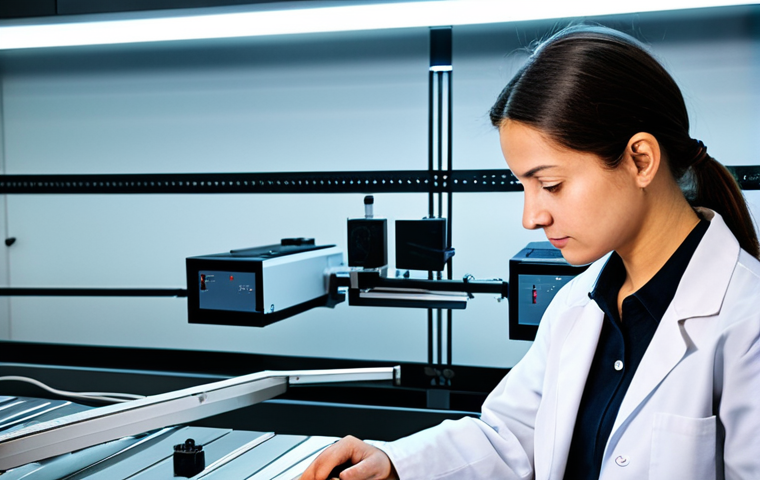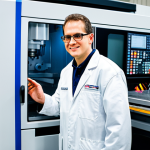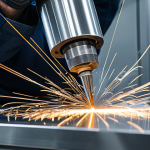Stepping into the world of aluminum machining, it often feels like entering a high-stakes game where precision isn’t just a goal, but the very air you breathe.
Anyone who’s truly worked with this incredibly versatile metal knows it’s far more than just cutting and shaping; it’s about mastering its quirks, predicting its reactions, and coaxing out perfection.
From aerospace components demanding micron-level accuracy to everyday consumer electronics, the unsung heroes are the machinists and engineers who’ve cracked the code.
It’s a subtle art, honed over years, often by trial and error, a true blend of science and intuition. The ‘know-how’ in aluminum isn’t static; it’s a living, breathing body of knowledge constantly evolving.
I’ve personally seen how much the game has changed, even in just the last few years. Take sustainability, for instance. Optimizing chip evacuation for recycling isn’t just a green initiative anymore; it’s a financial imperative.
A robust chip management system, from my own experience, can slash waste disposal costs by a significant margin annually. Then there’s the exciting, albeit sometimes frustrating, push into AI and machine learning for predictive maintenance.
I remember a project last year where a sudden tool breakage nearly ruined a custom medical implant, costing us thousands. The idea of a system accurately predicting that an end mill will fail in three hours, preventing such costly mishaps and downtime?
It’s a game-changer that many shops, including my own, are wrestling with to implement, despite the initial learning curve. And let’s not forget the constant development of new aluminum alloys.
Just when you think you’ve mastered the machining characteristics of 6061, along comes a tougher, more abrasive series, demanding entirely different feeds, speeds, and tooling strategies.
It feels like chasing a moving target sometimes, but the incredible strength-to-weight ratios these new materials offer for electric vehicle parts or lightweight drones are simply too compelling to ignore, even with the machining headaches they introduce.
Overlay all of this with the volatile global supply chains – the price of raw aluminum, influenced by geopolitical shifts, can instantly erode your profit margins.
Adapting to these economic realities is as much a part of the essential know-how now as understanding chip load or thermal expansion. The shift towards bespoke, on-demand components also means our setups need to be more agile than ever, pushing for rapid prototyping and quick changeovers.
It’s exhilarating, seeing a unique part go from concept to completion in mere days, knowing you played a direct hand in bringing someone’s specific vision to life.
We’ll explore this precisely.
The Unseen Language of Tooling: Matching the Metal’s Mood

Anyone who’s spent a significant amount of time on the shop floor, truly getting their hands dirty with aluminum, knows that choosing the right tool isn’t just about grabbing a standard end mill.
It’s a deep dive into the specific alloy, its temper, and what you’re trying to achieve. I’ve personally walked into countless situations where a simple tool change, seemingly minor to an outsider, transformed a chattering, ugly cut into a smooth, mirror-like finish.
It’s often about understanding the material’s ‘mood’ – whether it’s soft and gummy, requiring sharper edges and higher rake angles to prevent built-up edge, or tougher, more abrasive variants like some aerospace alloys that demand specialized coatings and geometries to resist wear.
You can almost feel the difference in the way the tool bites, or refuses to, and a seasoned machinist develops an intuition for it. This isn’t something you learn from a textbook; it’s forged through hours of trial and error, of ruining parts, and then finally, celebrating a perfect finish.
1. Selecting Geometries for Optimal Chip Flow
The geometry of your cutting tool is paramount when working with aluminum. From my own early experiences, I quickly learned that a sharp, positive rake angle is your best friend.
Why? Because it slices through the material rather than pushing it, reducing cutting forces and minimizing heat generation – both critical for aluminum.
You want those chips to evacuate cleanly, not to pack into flutes or re-cut, which leads to surface finish degradation and premature tool wear. I’ve seen workshops struggle for days with gummy aluminum until someone finally switches to an end mill with a higher helix angle or a specialized polished flute, and suddenly, it’s like magic.
It’s truly astonishing how a slight tweak in tool design can unlock entirely new levels of efficiency and surface quality. For me, it’s often a game of balancing between maximum material removal rates and achieving that pristine finish, especially on visible components.
2. The Imperative of Coatings and Substrates
While uncoated carbide tools often work well for many aluminum applications, the moment you step into high-volume production or more challenging alloys, coatings become indispensable.
I remember a particularly frustrating job involving a significant quantity of 7075-T6 parts, where our standard tools were wearing out far too quickly.
It felt like we were just burning money. After some research and a few trials, we switched to tools with a diamond-like carbon (DLC) coating. The difference was night and day.
The slick, low-friction surface of the DLC reduced sticking and galling, extended tool life dramatically, and yielded a much better surface finish. Similarly, the choice of carbide substrate – whether fine-grain or coarser – influences toughness and wear resistance.
It’s about matching the tool’s inherent strength with the demands of the cut, ensuring it can withstand the forces without fracturing, especially in interrupted cuts.
Thermal Management: Keeping Cool Under Pressure
Aluminum’s high thermal expansion coefficient and relatively low melting point make heat management a non-negotiable aspect of successful machining. If you don’t control the heat, you’re inviting a host of problems: dimensional inaccuracy, tool welding, accelerated wear, and terrible surface finishes.
I’ve personally been on the receiving end of parts that ‘looked’ right coming off the machine, only to discover, after they cooled down, that they were significantly out of tolerance.
It’s a humbling experience that teaches you the invisible forces at play. Understanding where the heat is generated – primarily from the friction between the tool and the workpiece, and plastic deformation of the material – is the first step toward mitigating its effects.
This isn’t just about flooding the part with coolant; it’s a holistic approach that integrates tool choice, cutting parameters, and coolant application strategy.
1. Coolant Application Strategies Beyond Flooding
While flood coolant is a common and often effective method, it’s not always the optimal solution for every aluminum machining scenario. I’ve experimented with and implemented various techniques.
Minimum Quantity Lubrication (MQL), for instance, has been a revelation for certain applications in my own experience. Instead of gallons of coolant, you’re delivering a fine mist of lubricant and air directly to the cutting zone.
This not only reduces waste and cleanup but, surprisingly, can often provide better lubrication at the chip-tool interface, leading to improved tool life and surface finish, particularly in deep pocketing or drilling operations where chips might pack.
Then there’s compressed air for dry machining, which, while reducing lubrication, excels at chip evacuation in certain situations, preventing re-cutting and heat buildup from chips themselves.
It’s about finding the balance between cooling, lubrication, and chip removal for your specific process.
2. Controlling Heat Generation Through Cutting Parameters
Beyond coolant, the most significant levers we have for managing heat are our cutting parameters. High surface speeds are often desirable for aluminum, as they tend to reduce the heat transferred into the workpiece, diverting more of it into the chips.
However, this needs to be balanced with appropriate feed rates and chip loads. A common mistake I’ve seen, and made myself, is trying to push too hard with too small a chip load, leading to excessive rubbing and heat generation rather than efficient chip formation.
A higher chip load, paradoxically, can sometimes lead to cooler machining by creating a thicker, more efficiently formed chip that carries heat away quickly.
It’s a delicate dance, where adjustments of just a few hundred RPM or a few thousandths of an inch per tooth can radically alter the thermal dynamics of the cut.
The Crucial Role of Chip Evacuation
If you’ve ever machined aluminum without a robust chip evacuation strategy, you know the frustration. Chips pile up, get re-cut, scratch your beautiful surface, weld to the tool, and even damage the part or break the tool.
It’s a messy, expensive nightmare. For me, a clean work zone is not just aesthetically pleasing; it’s a direct indicator of an efficient, stable machining process.
Managing aluminum chips, which can be long and stringy, or powdery and abrasive, depending on the alloy and cutting parameters, requires a multi-faceted approach.
I’ve seen incredible innovations in this area, from specialized tool geometries to advanced machine features, all designed to ensure those chips get out of the cutting zone and into the recycling bin as quickly as possible.
1. Tooling Features for Chip Control
Modern tooling isn’t just about cutting edges; it’s about chip control. Tools designed specifically for aluminum often feature wider, polished flutes to promote smooth chip flow and prevent adhesion.
I’ve found that variable helix end mills, for instance, are fantastic for breaking up harmonic vibrations that can lead to poor surface finish, but they also contribute to better chip evacuation by distributing the cutting forces more evenly.
Some tools even incorporate chip splitters or unique edge preparations that segment the chips into smaller, more manageable pieces, preventing long, stringy tangles.
This is particularly valuable in deep slotting or pocketing operations where chip evacuation is inherently challenging. It’s a testament to how much thought goes into tool design beyond just the initial cut.
2. Integrated Chip Management Systems
Beyond the tool itself, the machine’s capabilities play a huge role. High-pressure through-spindle coolant systems are invaluable for blasting chips out of deep holes or tight pockets.
Air blast systems can be effective for dry machining. And then there are the internal machine designs: steeply sloped work zone walls, efficient chip conveyors, and even high-volume coolant pumps designed to flood chips away.
I remember a new machine we installed with an improved chip conveyor; it felt like a significant upgrade, not just in terms of tidiness but also in reducing downtime previously spent manually clearing chip nests.
This comprehensive approach, from tool to machine, is what truly defines effective aluminum chip management.
| Parameter | Impact on Aluminum Machining | Common Issues from Poor Control |
|---|---|---|
| Tool Geometry | Influences chip formation, heat generation, surface finish, and tool life. Positive rake, sharp edges are key. | Built-up edge, poor surface finish, tool breakage, short tool life. |
| Coolant Type/Application | Reduces heat, lubricates, and aids chip evacuation. MQL vs. Flood vs. Dry. | Dimensional inaccuracy, tool welding, chip packing, accelerated wear. |
| Spindle Speed (RPM) | Affects cutting forces, heat distribution, and material removal rates. High RPM often preferred for aluminum. | Excessive heat buildup, vibration, poor surface quality. |
| Feed Rate (IPM) / Chip Load | Determines chip thickness and material removal volume. Higher chip load can mean cooler machining. | Rubbing, premature tool wear, poor surface finish, long chips. |
| Chip Evacuation Method | Ensures chips are removed from cutting zone, preventing re-cutting and damage. | Scratched parts, tool breakage, machine downtime, poor surface finish. |
Precision Metrology: The Unsung Hero of Quality
In aluminum machining, especially for critical components in sectors like aerospace or medical devices, “close enough” simply isn’t an option. Precision metrology isn’t just a final inspection step; it’s an integrated part of the process, ensuring that every dimension, every tolerance, is met with absolute certainty.
I’ve always seen it as the ultimate feedback loop, telling you whether your process is truly dialed in. There’s a certain thrill in taking a part off the machine, running it through a CMM, and seeing that every single feature is within its tight limits.
It’s a confirmation of expertise, but also a stark reminder of how quickly things can go sideways if you’re not vigilant.
1. On-Machine vs. Off-Machine Inspection
The debate between on-machine and off-machine inspection is ongoing, and my personal preference often depends on the complexity and volume of the parts.
On-machine probing, for instance, has revolutionized setup times and in-process quality checks. I’ve seen it save hours by automatically setting work offsets or verifying critical features mid-cycle, alerting you to potential issues before an entire batch is ruined.
This immediate feedback is invaluable, especially for complex 5-axis parts where removing and re-fixturing the part for inspection can introduce new errors.
However, for the most rigorous final inspection, or for statistical process control across batches, dedicated CMMs (Coordinate Measuring Machines) with their higher accuracy and comprehensive reporting capabilities are indispensable.
It’s about leveraging the strengths of each method to build confidence in your output.
2. The Significance of Temperature Compensation
Given aluminum’s propensity to expand and contract with temperature fluctuations, understanding and compensating for thermal changes is crucial for achieving tight tolerances.
I remember a project where we were machining a large aluminum fixture in a shop with fluctuating ambient temperatures. What seemed perfectly in spec on the machine would be off by several thousandths once it reached room temperature, leading to frustrating reworks.
This led us to invest in more precise temperature-controlled environments for our critical machining operations, and also to incorporate temperature compensation strategies into our programming and measurement routines.
It’s a subtle but profoundly impactful aspect of precision machining that often gets overlooked by those who aren’t deeply immersed in the world of high-tolerance aluminum.
Advanced Machining Techniques: Pushing Aluminum’s Boundaries
The landscape of aluminum machining is constantly evolving, with new techniques emerging that allow us to create geometries and achieve efficiencies that were once unimaginable.
This isn’t just about incrementally improving existing processes; it’s about fundamentally rethinking how we interact with the material. I’ve personally been involved in projects where adopting one of these advanced techniques dramatically reduced lead times or enabled the creation of components that simply couldn’t be made with conventional methods.
It’s exhilarating to be on the cutting edge, even if it means a steep learning curve and investing in new equipment or software.
1. The Power of 5-Axis Machining
For anyone serious about complex aluminum components, 5-axis machining is no longer a luxury; it’s a necessity. The ability to articulate the cutting tool along multiple axes simultaneously, reaching features that would be impossible with 3-axis machines, completely transforms what you can produce.
I remember a prototype aerospace bracket we had to machine, with incredibly intricate pockets and contoured surfaces. Trying to do it with a 3-axis machine would have required multiple setups, complex fixtures, and significant manual intervention.
With a 5-axis machine, we were able to complete the part in a single setup, not only saving hours of time but also drastically improving accuracy by eliminating re-fixturing errors.
It opens up a whole new world of design possibilities, allowing engineers to truly optimize part geometry for performance rather than for ease of manufacturing with limited tools.
2. High-Speed Machining (HSM) for Efficiency
High-Speed Machining (HSM) has fundamentally reshaped how we approach aluminum. It’s not just about spinning the spindle faster; it’s a holistic strategy involving high spindle speeds, relatively light radial depths of cut, and high feed rates.
The goal is to generate very thin, uniform chips that carry heat away efficiently, minimizing heat transfer to the workpiece and tool. From my own experience, implementing HSM has led to dramatically reduced cycle times, extended tool life (counter-intuitively, because the tool spends less time in contact with the material and experiences less heat buildup), and superior surface finishes.
The sound of an HSM machine cutting aluminum, with its high-pitched whine and the almost continuous shower of small, perfectly formed chips, is music to a machinist’s ears.
It demands rigid machines, high-performance tooling, and sophisticated CAM software, but the investment often pays for itself quickly through increased throughput.
Troubleshooting Common Machining Challenges
No matter how much experience you have, machining aluminum will occasionally throw you a curveball. Tools break, finishes degrade, and dimensions drift.
The real mark of an expert, in my opinion, isn’t that they never encounter problems, but that they know how to systematically diagnose and resolve them.
I’ve learned invaluable lessons from every mistake, every unexpected chatter, and every ruined part. It’s these moments of frustration that often lead to the deepest learning and the most significant breakthroughs in process optimization.
It’s about being a detective, looking for clues in the chips, the sound, the surface finish, and the machine’s behavior.
1. Diagnosing Surface Finish Issues
A poor surface finish on aluminum can be maddeningly elusive to diagnose. Is it chatter? Is it built-up edge?
Is it chip re-cutting? Each requires a different solution. I often start by checking for tool wear – even a slight rounding of the cutting edge can drastically impact finish quality.
Then I’ll look at the cutting parameters: too low a feed rate can cause rubbing, too high can lead to heavy tool marks. Vibrations, whether from an unbalanced tool, worn spindle bearings, or an unstable workholding setup, are notorious for causing chatter marks.
My personal approach often involves a methodical reduction of variables: check the tool, then adjust speeds/feeds incrementally, then look at workholding rigidity.
Sometimes, just changing the helix angle of the end mill or optimizing the entry/exit strategy can eliminate an otherwise persistent surface defect.
2. Mitigating Dimensional Inaccuracies
Dimensional inaccuracies in aluminum parts are often linked to heat, tool deflection, or machine inaccuracies. My first thought usually goes to thermal expansion – is the part cooling down and shrinking after machining?
If so, compensating for that temperature difference or maintaining a more consistent shop temperature becomes critical. Tool deflection is another major culprit, especially with long, slender tools or aggressive cuts.
I’ve found that using shorter tools, applying lighter radial cuts, or implementing roughing/finishing passes can help manage this. Lastly, checking machine calibration and backlash is important.
A worn ball screw or misaligned axis can lead to cumulative errors that become apparent only after a part is fully machined. It’s a systematic process of elimination, often requiring multiple iterations to pinpoint the root cause.
The Human Element: Cultivating Mastery
Beneath all the advanced machines, sophisticated software, and specialized tooling, the true magic of aluminum machining lies in the human hands and minds operating it.
No algorithm, no matter how advanced, can replicate the nuanced intuition, problem-solving ability, and sheer experience that a skilled machinist brings to the table.
I’ve been fortunate to learn from some true masters of the craft, people who could hear a slight change in the cutting sound and immediately know what adjustment was needed.
This isn’t just a job; it’s a craft that demands continuous learning and a passion for precision.
1. The Value of Hands-On Experience and Mentorship
There’s no substitute for hands-on experience. You can read all the books, watch all the videos, but until you’ve felt the vibrations, smelled the hot chips, and seen the direct impact of a parameter change, you haven’t truly learned.
I attribute a significant part of my own expertise to the countless hours I’ve spent on the shop floor, experimenting, failing, and eventually succeeding.
Furthermore, the role of mentorship is absolutely critical. I remember a veteran machinist who took me under his wing, patiently explaining the subtle cues of the machine, sharing anecdotes from his decades of experience.
Those informal lessons, delivered through practical demonstrations and shared insights, were far more impactful than any formal training I received. We need to foster environments where this knowledge can be passed down, ensuring the next generation of machinists can build upon the wisdom of those who came before.
2. Continuous Learning in a Dynamic Industry
The world of machining, especially with materials like aluminum, is never static. New alloys, new tools, new machines, and new software are constantly emerging.
If you’re not learning, you’re falling behind. I make it a point to regularly attend industry trade shows, read technical journals, and participate in online forums.
It’s not just about keeping up; it’s about actively seeking out the next innovation that could give us an edge. For instance, the rapid advancements in generative design and additive manufacturing, while not direct machining, are influencing how parts are designed and what is expected of the final machined component.
Staying curious, embracing new technologies, and always being open to refining your techniques is essential for anyone who wants to not just survive but thrive in this exciting and demanding field.
Closing Thoughts
As we’ve explored, mastering aluminum machining is far more than just pressing a button; it’s an intricate dance between material science, advanced technology, and human intuition.
Every aspect, from the sharpness of a tool’s edge to the subtle hum of a perfectly balanced spindle, contributes to the final outcome. It’s a field that constantly challenges you, but also rewards you with the profound satisfaction of turning raw material into perfectly formed components.
Embrace the learning curve, trust your instincts, and never stop experimenting – that’s where true mastery truly begins.
Good to Know Information
1. Aluminum Alloys Vary Significantly: Not all aluminum is created equal. The specific alloy (e.g., 6061, 7075, 2024) dictates its machinability, chip formation, and heat characteristics. Always research the alloy’s properties before you begin.
2. Tooling is an Investment, Not an Expense: Skimping on quality cutting tools for aluminum will almost always cost you more in the long run through reduced tool life, poor surface finishes, and increased scrap rates. Invest in reputable brands and specialized geometries.
3. Coolant Health is Crucial: Beyond just volume, the cleanliness and concentration of your coolant directly impact tool life, surface finish, and even operator health. Regular maintenance and monitoring are non-negotiable for efficient aluminum machining.
4. Listen to Your Machine: The sounds and vibrations your machine makes during cutting are invaluable diagnostic tools. A change in pitch or an increase in chatter often signals an impending problem long before visual cues appear.
5. Workholding Rigidity is Paramount: For light and sometimes flexible materials like aluminum, ensuring your workpiece is held absolutely rigid is essential to prevent chatter, vibration, and dimensional inaccuracies. Don’t overlook the importance of proper fixturing.
Key Takeaways
Mastering aluminum machining hinges on a holistic approach that integrates optimal tool selection (geometry, coatings), precise thermal management (coolant, parameters), and efficient chip evacuation.
Leveraging advanced techniques like 5-axis machining and High-Speed Machining can unlock unparalleled efficiency and complexity. Ultimately, successful aluminum machining is driven by meticulous quality control, systematic troubleshooting, and the irreplaceable human element of hands-on experience, mentorship, and a commitment to continuous learning in a dynamic industry.
Frequently Asked Questions (FAQ) 📖
Q: How has the “know-how” in aluminum machining truly evolved beyond just cutting and shaping, especially with new challenges and opportunities emerging?
A: Oh, it’s no longer just about the cut; it’s a living, breathing beast of knowledge, constantly pushing us. I’ve personally seen how much has changed, even in just the last few years.
Take sustainability, for instance – optimizing chip evacuation isn’t just “green” talk anymore, it’s straight-up financial sense. Getting that right can save a fortune annually in waste disposal.
Then there’s the exciting, albeit sometimes frustrating, push into AI for predictive maintenance. I mean, thinking back to that medical implant job last year where a sudden tool failure nearly cost us thousands – the idea of a system telling you, “Hey, that end mill’s got three hours left,” is truly revolutionary.
It’s a tough, steep learning curve to implement, believe me, but the potential to avoid those brutal, unscheduled downtimes? Absolutely worth the sweat.
Q: The text mentions a constant development of new aluminum alloys. What are the practical headaches these new materials introduce for machinists, and why are they still so compelling despite the difficulties?
A: Oh, the new alloys! It honestly feels like chasing a moving target sometimes. Just when you think you’ve finally got 6061 down to an art, along comes some tougher, more abrasive series that demands you rethink everything – feeds, speeds, even your go-to tooling strategies.
It can be incredibly frustrating, introducing real headaches on the shop floor as you experiment to find the sweet spot. But here’s the kicker: the incredible strength-to-weight ratios these materials offer for things like electric vehicle components or advanced, lightweight drones are just too compelling to ignore.
The performance benefits they unlock make all those machining headaches worth it, even if it means more trial and error to crack their specific code.
Q: Beyond the technical aspects of machining, what external economic factors are now crucial for success in the aluminum machining world, and how do shops adapt?
A: It’s absolutely not just about chips and speeds anymore; the economic landscape plays a huge, often volatile, role. I’ve watched as global supply chains, especially for raw aluminum, influenced by geopolitical shifts you’d never think would affect your shop, can instantly decimate profit margins.
You have to be incredibly agile to adapt to those price swings. And then there’s the increasing demand for bespoke, on-demand components. This means our setups need to be more agile than ever, pushing hard for rapid prototyping and incredibly quick changeovers.
It’s exhilarating, though – seeing a truly unique part go from just a concept to a finished product in a matter of days, knowing you were directly involved in bringing someone’s specific, often vital, vision to life.
That’s a different kind of reward entirely.
📚 References
Wikipedia Encyclopedia
구글 검색 결과
구글 검색 결과
구글 검색 결과
구글 검색 결과
구글 검색 결과




